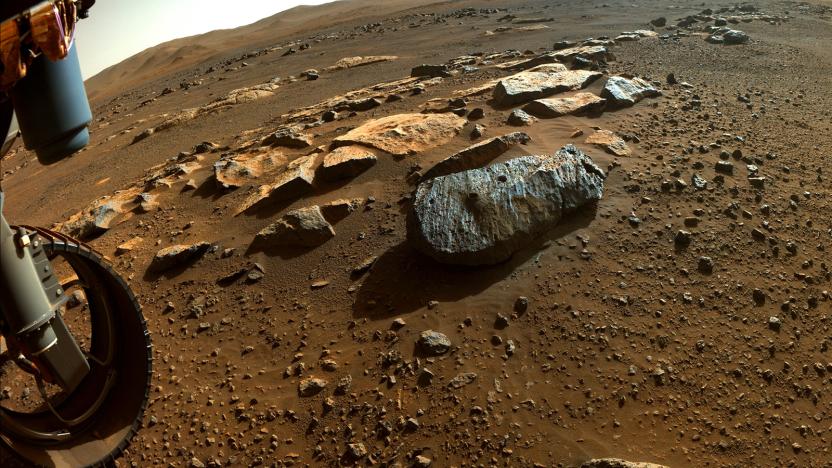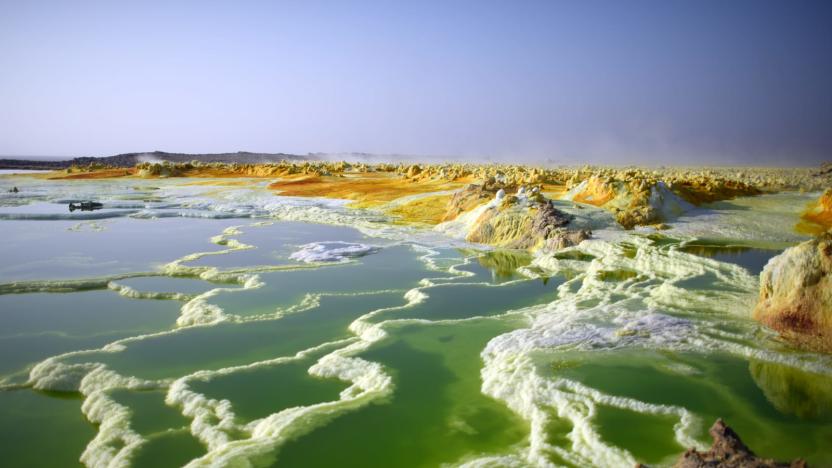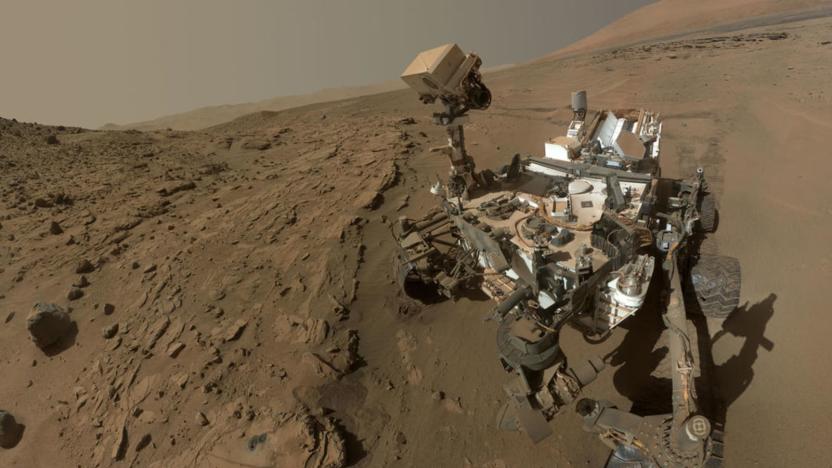exobiology
Latest

Europa's resemblance to Greenland bodes well for possible life on Jupiter's moon
Europa has features similar to Greenland, and they add to evidence that Jupiter's moon could support life.
Jon Fingas04.19.2022
Perseverance rover samples hint Mars had water for a long time
The first samples from NASA's Perseverance rover indicate Mars had water for a long time, creating a potentially ideal breeding ground for life.
Jon Fingas09.11.2021
NASA's Perseverance rover fails to collect its first Mars rock sample
NASA's Perserverance rover has failed to collect a Mars rock sample, and it's not yet clear what went wrong.
Jon Fingas08.07.2021
Study casts doubt on the chances of life on watery alien planets
Scientists searching for habitable planets often see the presence of water as a key sign, but they might not want to raise their hopes too high. A recently published study has indicated that there was no clear evidence of extremophiles (life that can survive extreme conditions) in Ethiopia's Danakil Depression, home to some of the world's most acidic, saltiest and superheated water. In other words, the mere existence of water isn't enough -- the conditions have to be at least slightly conducive to life. Accordingly, water that was 'just' very salty included numerous forms of extremophiles, including several newly discovered examples.
Jon Fingas11.03.2019
NASA confirms mission to Jupiter's moon Europa
NASA has been talking for years about sending a probe to Europa, and now it's locking down those plans. The agency has confirmed the next phase of its Europa Clipper mission, which will send a spacecraft to the Jovian moon to determine if it could support life. The move allows progress toward finishing and testing a final design for the spacecraft. The administration is developing for a 2023 launch target to ensure a "cost-effective" process, but it's prepared to launch as late as 2025.
Jon Fingas08.20.2019
Meteor impact may have started a 'mega-tsunami' on early Mars
There appears to be stronger evidence of a possible ocean on ancient Mars. A recent study indicates that the meteor that created the 75-mile Lomonosov crater may have produced a "mega-tsunami" that left its mark on the planet. Its rim is the same height as the estimated depth of the ocean and resembles marine craters on Earth. Also, a hole in the southern lip of the crater could have been the result of the ocean roaring back from that direction. Earlier evidence had hinted the ocean's shores were shaped by at least one impact in the same general area as the Lomonosov crater -- this latest study, however, has narrowed things down to a specific impact site.
Jon Fingas08.04.2019
Curiosity rover finds gas levels on Mars hinting at possibility of life
It's easy to get jaded about potential signs of life on Mars, but a recent discovery might raise eyebrows. The New York Times has learned that NASA's Curiosity rover has detected "startlingly high" levels of methane -- the gas typically produced by life as we know it. The quantities are still tiny at 21 parts per billion, but that's three times the amount Curiosity spotted during a surge in 2013. The rover's operators were reportedly surprised enough to pause regularly scheduled studies to obtain follow-up data, with the additional findings slated to arrive on June 24th.
Jon Fingas06.22.2019
NASA hopes to send a probe to Alpha Centauri in 2069
If you thought NASA was playing the long game with its plan to put people on Mars in the 2030s, you haven't seen anything yet. New Scientist has learned that a team at the administration's Jet Propulsion Laboratory has started planning a mission that would send a spacecraft to the Alpha Centauri system in... 2069. Yes, that's 52 years away, and timed around the 100th anniversary of Apollo 11's trip to the Moon. The probe would look for signs of life around the potentially habitable exoplanet Proxima b, giving humanity a much better look than it could get with observation from home.
Jon Fingas12.27.2017
NASA forms a coalition to look for life on other planets
NASA knows that it can't rely solely on astronomers and robotic rovers to find life on other worlds, so it's recruiting some help. The space agency has formed the Nexus for Exoplanet System Science (NExSS), a coalition of scientists who study astrophysics, Earth, other planets and the Sun. The group will use its collective knowledge to search for alien lifeforms using perspectives that NASA wouldn't always have -- how does the loss of atmospheric chemicals affect the chances for life, for example? NASA hopes that the group will not only determine the habitability of planets, but develop technology to study those planets in greater detail. There's no guarantee that NExSS will discover organisms, let alone organisms that you might see within your lifetime, but the odds of success are now a bit higher. [Image credit: NASA]
Jon Fingas04.22.2015
NASA thinks we'll find signs of extraterrestrial life in 20 years
The quest to find proof of life beyond Earth hasn't been without its setbacks, but NASA isn't deterred. If anything, it's optimistic -- Chief Scientist Ellen Stofan now claims that there will be "definitive evidence" of extraterrestrial life within the next 10 to 20 years. Given the sheer number of oceans within just our solar system, she argues, it's "not an if, it's a when." The more pressing questions are what kind of life we'll find, and how we'll find it. It'll most likely involve a probe or rover detecting microscopic organisms rather than a close encounter of the third kind, so there probably won't be much drama involved. Still, the very fact that we could find alien species within our lifetimes is exciting. [Image credit: Lynette Cook, NASA]
Jon Fingas04.08.2015
Curiosity finds evidence of life-giving nitrates in Mars rocks
NASA's Curiosity rover isn't done finding signs that Mars once had the prime ingredients for life... not by a longshot. The explorer robot has discovered evidence of nitrates, the nitrogen compounds that are some of the key nutrients for life, in rocks at three places near its landing site. This still doesn't mean that Mars did harbor life in its heyday, but it's now that much more likely. The big question is whether the processes that formed those nitrates are still active, or if they died out when the planet became barren -- scientists aren't sure, and it could take a while to get an answer.
Jon Fingas03.24.2015
The Big Picture: Exobiotanica, a bonsai tree in space
This is "Exobiotanica Botanical Space Flight," the latest project from Japanese artist Makoto Azuma. In tandem with JP Aerospace, self-described as " America's Other Space Program," Azuma set out to create beautiful imagery by sending a bonsai tree and a variety of other plants to space, using giant helium balloons and custom frames as the method of transportation. The results of Azuma's Exobiotanica project, which had its starting point in Block Rock Desert, Nevada, were spectacular to say the least, showing us what it's like for organic life to go where most humans haven't. Simply beautiful. [Image credit: AMKK]
Edgar Alvarez07.23.2014